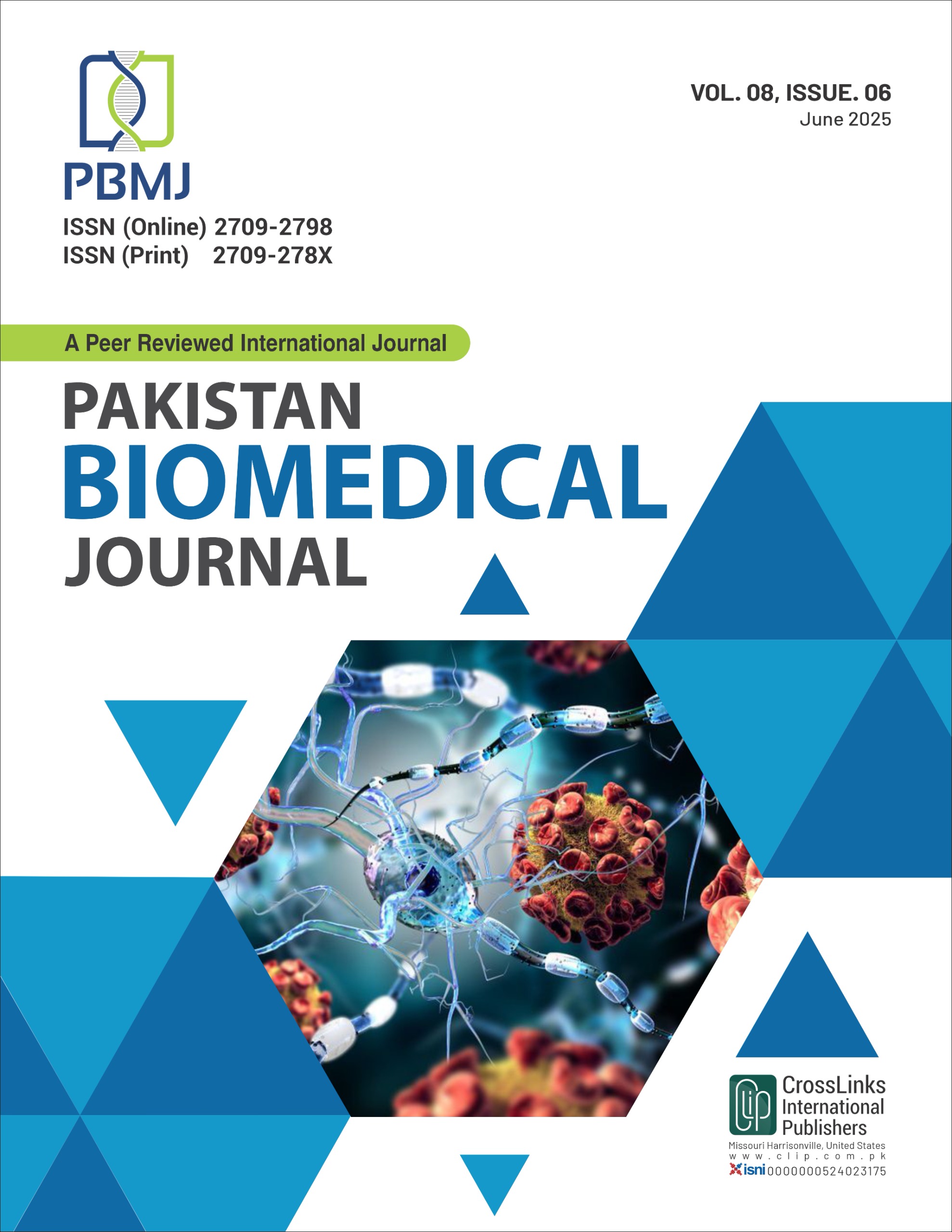Habit Reversal Training and Relaxation Training for the Treatment of Adult-Onset Trichotillomania due to Premature Greying
Habit Reversal and Relaxation in Adult Trichotillomania
DOI:
https://doi.org/10.54393/pbmj.v8i6.1229Keywords:
Trichotillomania, Habit Reversal Training, Stress Management, Relaxation Training, Behavioral InterventionAbstract
This case study demonstrates the use of Habit Reversal Training (HRT) combined with Relaxation Training (RT) in addressing trichotillomania. The subject, a 28-year-old woman, reported experiencing stress and frequent lateness to work. Her hair-pulling behavior, triggered by the early appearance of grey hair, led her to spend 30 to 60 minutes each morning pulling her hair, which contributed to her tardiness. Over the course of 14 weekly therapy sessions, interventions included self-monitoring, psychoeducation, identification and modification of visual triggers, stimulus-response strategies, and restructuring daily routines. The treatment resulted in reduced stress and effective control of hair-pulling behaviors. The case suggests that incorporating a hair care regimen into therapy may further enhance positive outcomes. It also highlights the importance of considering both psychological and societal influences in the development and treatment of trichotillomania.
References
Flessner CA, Woods DW, Franklin ME, Cashin SE, Keuthen NJ. Milwaukee inventory for styles of trichotillomania--adult version. PsycTESTS Dataset. 2008. doi:10.1037/t14240-000. DOI: https://doi.org/10.1037/t14240-000
Bennett LP and Ryznar R. A Review of Behavioral and Pharmacological Treatments for Adult Trichotillomania. Psychology International. 2024 Apr; 6(2): 509-30. doi: 10.3390/psycholint6020031. DOI: https://doi.org/10.3390/psycholint6020031
Bloch MH, Landeros-Weisenberger A, Dombrowski P, Kelmendi B, Wegner R, Nudel J et al. Systematic review: pharmacological and behavioral treatment for trichotillomania. Biological Psychiatry. 2007 Oct; 62(8): 839-46. doi: 10.1016/j.biopsych.2007.05.019. DOI: https://doi.org/10.1016/j.biopsych.2007.05.019
Twohig MP and Woods DW. A preliminary investigation of acceptance and commitment therapy and habit reversal as a treatment for trichotillomania. Behavior Therapy. 2004 Sep; 35(4): 803-20. doi: 10.1016/S0005-7894(04)80021-2. DOI: https://doi.org/10.1016/S0005-7894(04)80021-2
Grant JE and Chamberlain SR. Automatic and focused hair pulling in trichotillomania: Valid and useful subtypes?. Psychiatry Research. 2021 Dec; 306: 114269. doi: 10.1016/j.psychres.2021.114269. DOI: https://doi.org/10.1016/j.psychres.2021.114269
Woods DW, Twohig MP. Trichotillomania: An ACT-enhanced Behavior Therapy Approach Workbook. Oxford: Oxford University Press; 2008.
Odlaug BL, Chamberlain SR, Grant JE. Motor inhibition and cognitive flexibility in pathologic skin picking. Progress in Neuro-Psychopharmacology and Biological Psychiatry. 2010 Feb; 34(1): 208-11. doi: 10.1016/j.pnpbp.2009.11.008. DOI: https://doi.org/10.1016/j.pnpbp.2009.11.008
Mythen G, Walklate S, Peatfield EJ. Assembling and deconstructing radicalisation in PREVENT: A case of policy-based evidence making?. Critical Social Policy. 2017 May; 37(2): 180-201. doi: 10.1177/0261018316683463. DOI: https://doi.org/10.1177/0261018316683463
Lovibond PF and Lovibond SH. The structure of negative emotional states: Comparison of the Depression Anxiety Stress Scales (DASS) with the Beck Depression and Anxiety Inventories. Behaviour Research and Therapy. 1995 Mar; 33(3): 335-43. doi: 10.1016/0005-7967(94)00075-U. DOI: https://doi.org/10.1016/0005-7967(94)00075-U
Axas A. Are Brain Games really as they seem?. Scientific Kenyon: The Neuroscience Edition. 2023 Sep; 7(1): 107-15.
Winchel RM, Jones JS, Molcho A, Parsons B, Stanley B, Stanley M. The Psychiatric Institute Trichotillomania Scale (PITS). Psychopharmacology Bulletin. 1992; 28(4): 463-76.
Crosby JM, Dehlin JP, Mitchell PR, Twohig MP. Acceptance and commitment therapy and habit reversal training for the treatment of trichotillomania. Cognitive and Behavioral Practice. 2012 Nov; 19(4): 595-605. doi: 10.1016/j.cbpra.2012.02.002. DOI: https://doi.org/10.1016/j.cbpra.2012.02.002
Ricketts E, Bose D, Piacentini J. Obsessive‐Compulsive and Related Disorders. Child and Adolescent Psychopathology, Third Edition. 2017 Jan: 560-609. doi: 10.1002/9781394258932.ch17. DOI: https://doi.org/10.1002/9781394258932.ch17
Ong CW, Woods DW, Franklin ME, Saunders SM, Neal-Barnett AM, Compton SN et al. The role of psychological flexibility in acceptance-enhanced behavior therapy for trichotillomania: Moderation and mediation findings. Behaviour Research and Therapy. 2023 May; 164: 104302. doi: 10.1016/j.brat.2023.104302. DOI: https://doi.org/10.1016/j.brat.2023.104302
Falkenstein MJ, Mouton-Odum S, Mansueto CS, Goldfinger Golomb R, Haaga DAF. Comprehensive Behavioral Treatment of Trichotillomania. Behaviour Modification. 2016; 40(3): 376-396. doi:10.1177/0145445515616369. DOI: https://doi.org/10.1177/0145445515616369
Domínguez LN, Everett GJ, Jafferany M, Skurya J. Trichotillomania Treatment Update. Actas Dermosifiliogr. 2024; 115(2): 123-134. doi:10.1016/j.ad.2024.01.004. DOI: https://doi.org/10.1016/j.ad.2024.01.004
Richmond LM. Trichotillomania Etiology Differs Among Patients, Calls for Personalized Treatment. Psychiatry News. 2024; 59(8): 30-32. doi:10.1176/appi.pn.2024.08.8.30. DOI: https://doi.org/10.1176/appi.pn.2024.08.8.30
Grant JE and Chamberlain SR. Trichotillomania. American Journal of Psychiatry. 2016 Sep; 173(9): 868-74. doi: 10.1176/appi.ajp.2016.15111432. DOI: https://doi.org/10.1176/appi.ajp.2016.15111432
Halder A. Premature greying of hairs, premature ageing and predisposition to cancer in Jajjal, Punjab: a preliminary observation. Journal of Clinical and Diagnostic Research. 2007; 6: 577-80.
Farhat LC, Olfson E, Nasir M, Levine JLS, Li F, Miguel EC et al. Pharmacological and behavioral treatment for trichotillomania: An updated systematic review with meta-analysis. Depress Anxiety. 2020; 37(8): 715-727. doi:10.1002/da.23028. DOI: https://doi.org/10.1002/da.23028
Downloads
Published
How to Cite
Issue
Section
License
Copyright (c) 2025 Pakistan BioMedical Journal

This work is licensed under a Creative Commons Attribution 4.0 International License.
This is an open-access journal and all the published articles / items are distributed under the terms of the Creative Commons Attribution License, which permits unrestricted use, distribution, and reproduction in any medium, provided the original author and source are credited. For comments editor@pakistanbmj.com











